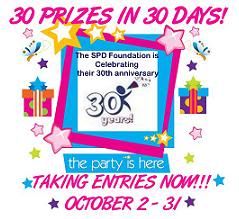Sensory-seeking vs. sensory-defensive
Okay......I've mentioned on here a few times that I was going to get around to explaining the ins-and-outs of SPD a bit more. Many of you "regulars" here have asked some great questions and, to be perfectly honest, most of you are already far ahead of the average population if you know that SPD stands for Sensory Processing Disorder. So in a hugely-simplified format, here goes.....
Sensory Processing Disorder is exactly what the name says--a glitch in sensory input and how it is processed by the brain, to such a degree that it makes overall life functioning difficult.(Remember.....we all have sensory issues to some degree. Our ability to cope and function is the key.) But there are about a gazillion ways that SPD can manifest, and it is very individualized.
There are two basic extremes to SPD. Sensory-seeking is on the one end, while sensory-defensive is on the other. An individual that tends to be sensory-seeking is one that generally has a diminished sensitivity to input, and therefore, increases activity and sensory input in order to "sense" it fully. (I know....read that sentence about five times and maybe it will make sense. No pun intended.) These tend to be your kids on the playground that are always wanting the swing to be pushed higher, they want the TV louder, they dance on the dining room table, they run around in the rain with no coat on, they dig into finger paints with gusto...always seeking MORE input.
Sensory-defensive is the other end of SPD. These are the kids that tend to hide under tables in noisy classrooms, tend to be clingy, can't stand tags in their clothing, cover their ears from loud noises, don't want their hands dirty, and sometimes don't even like to be touched or hugged by parents (even in infancy). These children are consider to be very sensitive, obviously, and don't want strong input.
Now.......a huge portion of SPD kids fall in between the two ends of the scale. In fact, many of them will send "mixed signals" which creates total havoc with diagnosis if you're not working with someone that understands how the brain reads sensory information. Sensory-seekers are often poor at judging when enough is enough, so they overload themselves with too much high-end activity and end up under a table somewhere with their ears covered trying to regain some balance, which looks like a sensory-defensive kid, right? And a child that can typically be sensory-seeking might be sensory-seeking in virtually every manner.....except that they have a tactile issue on their hands and can't deal with weird/slimy/sticky substances. Once again, if they are evaluated on a limited basis, they will appear to be sensory-defensive.
Once again, this is an extremely simplified version of SPD, but might give a little bit of insight into the basic degrees of what SPD can look like. Jennica tends to fall on the sensory-seeking side of the scale, but this varies from day to day, and is affected by a ton of outside influences. And, of course, now we know it is also highly affected by her diet.
And as you read this, keep in mind that I didn't touch on any factors of what auditory-processing disorder, visual-processing disorder, or any of those subsets look like. Overwhelmed yet?





2 comments:
Thank you so much for this post! I have just been researching SPD and came across your blog. My little boy is two and is also sensory seeking (as I learned earlier this month) and I just learned/realized he has tactile issues also. It is so confusing to me that he can be both and I have been reading tons of books to help me understand. The way you described it really helps me understand a whole lot more, especially how it fluctuates from day to day. Thank you!
Natalie Metler
Yay Sensory Seekers! My 2 year old little girl is a seeker as well. Thanks for the blog and helpful info. It is nice to have a place to feel "normal"
Post a Comment